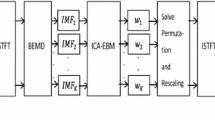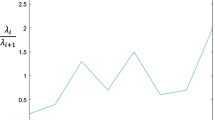Abstract
Blind source separation (BSS) of single-channel mixed recording is a challenging task that has applications in the fields of speech, audio and bio-signal processing. Ensemble empirical mode decomposition (EEMD)-based methods are commonly used for blind separation of single input multiple outputs. However, all of these EEMD-based methods appear in the edge effect problem when cubic spline interpolation is used to fit the upper and lower envelopes of the given signals. It is therefore imperative to have good methods to explore a more suitable design choice, which can avoid the problems mentioned above as much as possible. In this paper we present a novel single-mixture blind source separation method based on edge effect elimination of EEMD, principal component analysis (PCA) and independent component analysis (ICA). EEMD represents any time-domain signal as the sum of a finite set of oscillatory components called intrinsic mode functions (IMFs). In extreme point symmetry extension (EPSE), optimum values of endpoints are obtained by minimizing the deviation evaluation function of signal and signal envelope. Edge effect is turned away from signal by abandoning both ends’ extension parts of IMFs. PCA is applied to reduce dimensions of IMFs. ICA finds the independent components by maximizing the statistical independence of the dimensionality reduction of IMFs. The separated performance of edge EPSE-EEMD-PCA-ICA algorithm is compared with EEMD-ICA and EEMD-PCA-ICA algorithms through simulations, and experimental results show that the former algorithm outperforms the two latter algorithms with higher correlation coefficient and lower relative root mean square error (RRMSE).
















Similar content being viewed by others
References
H.I. Ashiba, K.H. Awadalla, S.M. El-Halfawy, F.E. Abd El-Samie, Adaptive least squares interpolation of infrared images. Circuits Syst. Signal Process. 30(3), 543–551 (2011)
F.R. Bach, M.I. Jordan, Blind one-microphone speech separation: a spectral learning approach. Adv. Neural Inf. Process. Syst. 16, 65–72 (2004)
B.L. Barnhart, W.E. Eichinger, Analysis of sunspot variability using the Hilbert–Huang transform. Sol. Phys. 269(2), 439–449 (2011)
A. Dapena, D. Iglesia, C.J. Escudero, An MSE-based method to avoid permutation/gain indeterminacy in frequency-domain blind source separation. Circuits Syst. Signal Process. 29(3), 403–417 (2010)
M.E. Davies, C.J. James, Source separation using single channel ICA. Signal Process. 87, 1819–1832 (2007)
W. Deng, F. Zhang, L. Zheng, Removal function model and experiment of edge effect. Infrared Laser Eng. 40(9), 1743–1748 (2011)
B. Gao, W.L. Woo, S.S. Dlay, Single-channel source separation using EMD-subband variable regularized sparse features. IEEE Trans. Audio Speech Lang. Process. 19(4), 961–976 (2011)
Y. Guo, Y. Li, Single channel electromyography blind recognition system of 3D hand. Comput. Appl. Softw. 27(9), 234–236 (2010)
Y. Guo, D. Zhou, Single channel surface electromyography blind recognition model based on watermarking. J. Vib. Control 18(1), 42–47 (2011)
Y. Guo, S. Huang, Y. Li, Single-mixture source separation using dimensionality reduction of ensemble empirical mode decomposition and independent component analysis. Circuits Syst. Signal Process. 31(6), 2047–2060 (2012)
M.E. Hamid, K. Ogawa, T. Fukabayashi, Improved single-channel noise reduction method of speech by blind source separation. Acoust. Sci. Technol. 28(3), 153–164 (2007)
H. Hu, Y.F. Dai, X.Q. Peng, J. Wang, Research on reducing the edge effect in magnetorheological finishing. Appl. Opt. 50(9), 1220–1226 (2011)
N.E. Huang, The empirical mode decomposition and the Hilbert spectrum for nonlinear and non-stationary time-series analysis. Proc. R. Soc., Math. Phys. Eng. Sci. 454(197), 903–995 (1998)
N.E. Huang, M.L. Wu, S.R. Long, S.S. Shen, W.D. Qu, P. Gloersen, K.L. Fan, The empirical mode decomposition and the Hilbert spectrum for nonlinear and non-stationary time series analysis. Proc. R. Soc. Lond. 454A, 903–993 (1971)
A. Hyvärinen, E. Oja, Independent component analysis: algorithms and application. Neural Netw. 13(4–5), 411–430 (2000)
A. Hyvärinen, J. Karhunen, E. Oja, Independent Component Analysis (Wiley, New York, 2001). ISBN 978-0-471-40540-5
I.M.S. Panahi, K. Venkat, Blind identification of multi-channel systems with single input and unknown orders. Signal Process. 89, 1288–1310 (2009)
I.T. Jolliffe, Principal Component Analysis, 2nd edn. Series: Springer Series in Statistics (Springer, New York, 2002). ISBN 978-0-387-95442-4
T. Kristjansson, J. Hershey, P. Olsen, S. Rennie, R. Gopinath, Super-human multi-talker speech recognition: the IBM2006 speech separation challenge system, in Proceedings of the International Conference on Spoken Language Processing (INTERSPEECH), Pittsburgh, Pennsylvania (2006), pp. 97–100
J. Lin, A. Zhang, Fault feature separation using wavelet-ICA filter. NDT E Int. 38(6), 421–427 (2005)
J. Liu, J. Zhou, H. Luo, X. Kong, Y. En, Q. Shi, Y. He, Total-dose-induced edge effect in SOI NMOS transistors with different layouts. Microelectron. Reliab. 50(1), 45–47 (2010)
H.-G. Ma, Q.-B. Jiang, Z.-Q. Liu, G. Liu, Z.-Y. Ma, A novel blind source separation method for single-channel signal. Signal Process. 90(12), 3232–3241 (2010)
B. Mijovic, M.D. Vos, I. Gligorijevic, J. Taelman, S.V. Huffel, Source separation from single-channel recordings by combining empirical-mode decomposition and independent component analysis. IEEE Trans. Biomed. Eng. 57(9), 2188–2196 (2010)
W.B.A.B. Mikhael, R.A. Ranganathan, T.B. Yang, Complex adaptive ICA employing the conjugate gradient technique for signal separation in time-varying flat fading channels. Circuits Syst. Signal Process. 29(3), 469–480 (2010)
G.R. Naik, D.K. Kumar, M. Palaniswami, Multi-run ICA and surface EMG based signal processing system for recognising hand gestures. IEEE Comput. Inf. Technol. 2008, 700–705 (2008)
K. Pearson, On lines and planes of closest fit to systems of points in space. Philos. Mag. 2(6), 559–572 (1901)
S.T. Roweis, One microphone source separation. Adv. Neural Inf. Process. Syst., 793–799 (2000)
J. Seo, X. Liu, D. Kim, K. Sohn, An objective video quality metric for compressed stereoscopic video. Circuits Syst. Signal Process. 31(3), 1089–1107 (2012)
Z. Shu, Z. Yang, A better method for effectively suppressing end effect of empirical mode decomposition (EMD). J. Northwestern Polytech. Univ. 24(5), 639–642 (2006)
G. Tzagkarakis, M. Papadopouli, P. Tsakalides, Singular spectrum analysis of traffic workload in a large-scale wireless LAN, in CDROM of Proceedings MSWIM’07, Chania, Crete Island, Greece, 22–26 October 2007, pp. 22–26
R.M. Udrea, D.N. Vizireanu, S. Ciochina, An improved spectral subtraction method for speech enhancement using a perceptual weighting filter. Digit. Signal Process. 18, 581–587 (2008)
R.M. Udrea, D.N. Vizireanu, S. Ciochina, S. Halunga, Nonlinear spectral subtraction method for colored noise reduction using multi-band Bark scale. Signal Process. 88(5), 1299–1303 (2008)
A. Vega, N. Osawa, S. Rashed, H. Murakawa, Analysis and prediction of edge effect on inherent deformation of thick plates formed by line heating. Comput. Model. Eng. Sci. 69(3), 261–279 (2010)
K. Wakabayashi, S. Dutta, Nanoscale and edge effect on electronic properties of grapheme. Solid State Commun. 152(15), 1420–1430 (2012)
T. Wang, H.B. Cheng, Y.P. Feng, Z.C. Dong, Simulation analysis of edge effect in typical optical processing. Trans. Beijing Inst. Technol. 31(9), 1100–1103+1126 (2011)
W.F. Wu, X.H. Chen, X.J. Su, Blind source separation of single-channel mechanical signal based on empirical mode decomposition. J. Mech. Eng. 47(4), 213–216 (2011)
Z. Xie, J. Feng, Codebook design for vector quantization based on a kernel fuzzy learning algorithm. Circuits Syst. Signal Process. 30(5), 999–1010 (2011)
Y. Yuan, C.M. Li, T.Y. Wang, X. Zhao, Fault diagnosis and classification for bearing based on EMD-ICA, in International Conference of Electronic and Mechanical Engineering and Information Technology (EMEIT) (2011), pp. 2715–2718
H. Zhang, L. Li, W. Li, Independent component analysis based on fast proximal gradient. Circuits Syst. Signal Process. 31(2), 583–593 (2012)
Acknowledgements
Funding for this work was supported by 2010 research project of Shanxi Scholarship Council of China [Nos. 92, 20101069], 2011 research project of Department of Human Resources and Social Security of Shanxi Province [No. 20121030], 2012 The ShanXi Science and Technology Department [No. 2012081036], 2012 graduate students’ innovative project of Department of Science and Technology of Taiyuan City [No. 120164034] and 2010 Youth Foundation of Taiyuan University of Science and Technology of China [No. 20103004].
Author information
Authors and Affiliations
Corresponding author
Rights and permissions
About this article
Cite this article
Guo, Y., Huang, S., Li, Y. et al. Edge Effect Elimination in Single-Mixture Blind Source Separation. Circuits Syst Signal Process 32, 2317–2334 (2013). https://doi.org/10.1007/s00034-013-9556-9
Received:
Revised:
Published:
Issue Date:
DOI: https://doi.org/10.1007/s00034-013-9556-9




